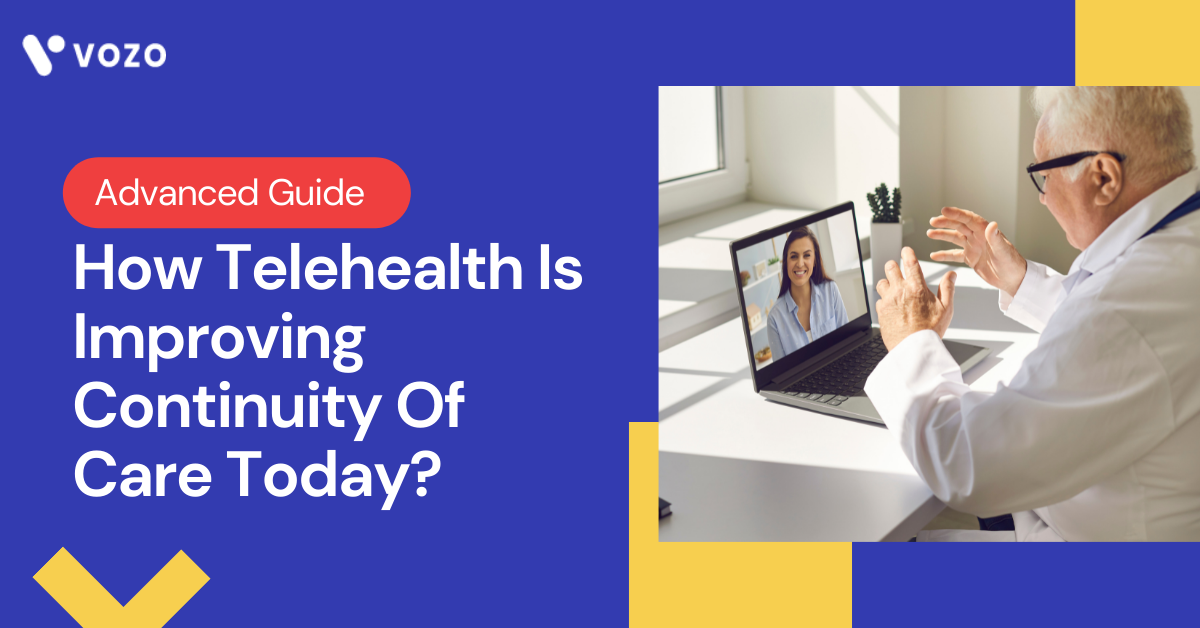How Telehealth Is Improving Continuity Of Care Today?
Maintaining continuity of care, and managing patients with chronic diseases, has always been a difficult proposition. However, the COVID-19 pandemic has made it even more difficult. Fear of exposure to the virus has led to many patients with chronic conditions avoiding care.
To ensure better continuity of care for our patients who need it most, many primary care practices are adopting fully integrated telehealth platforms like Vozo to offer complete, specialist-guided care to at-risk patients as safely as possible.
Many practices have found telehealth empowers primary care physicians to address two major challenges: lapses in care for chronic patients—leading to acute crises—and the increased burden on our health system from sudden waves of high-acuity cases.
Treating Primary Care Patients with Telehealth
Regarding the first challenge, chronic care and comorbid patients are unable to maintain appointments as usual during the pandemic, yet they are still in need of care. These patients often require a care team, including specialist doctors, to engage with patients who are due for a visit or in need of routine care. Maintaining a regular care regimen and enabling these patients to continue interfacing with their care team is key to improving outcomes.
Establishing a telehealth platform allowed primary care providers to proactively care for patients as they track those who fall outside of typical buffers and may be due for an appointment. Through telehealth, PCPs can engage with these patients to ensure they’re keeping up with their care needs.
Reducing Hospital Burden With Telehealth
Improving access to care in this way helps primary care physicians to avoid the downstream challenge of overburdened hospitals and emergency departments in particular.
When patients avoid proactive and non-urgent (but necessary) care, there is an increased burden to both patients and the healthcare system in the long run. By being available for routine care, and by proactively following up with patients, telehealth improves outcomes and reduces the upcoming strain on the healthcare system caused by a wave of patients seeking care that was put off.
Vozo specifically assists primary care providers in preventing a backlog of specialty referrals from occurring once these providers are again able to take non-urgent appointments.
RELATED: How Telehealth Benefits Chronic Pain Patients During COVID-19?
Both primary care providers & patients are adopting telehealth today!
With any major shift in how we provide care to our patients, it’s expected that there will be hiccups and speed bumps as both patients and providers adapt to the change. We have found the transition to focusing on telehealth during the COVID-19 pandemic to be surprisingly smooth, with both patients and providers expressing satisfaction with our new telehealth capabilities.
Most patients share resoundingly positive feedback when dealing with telehealth. Patients in need of routine specialty care have been delighted to find that their needs can be met without the need for an in-person appointment.
Certainly, many patients will be glad to get back to something approaching normal. But overall, most patients have been blown away by the sheer volume of treatments and care maintenance that can be administered via telemedicine and telehealth.
Providers, meanwhile, are also enjoying providing care via telehealth. Primary care teams as a whole feel empowered by the access to specialist input that is available when partnering with robust telehealth platforms such as Vozo.
Now, they can address both primary care needs and many specialty care needs that are crucial for our chronic and comorbid patients.
Furthermore, telehealth quite simply enables primary care practices to remain in operation at a much higher capacity than would be possible otherwise. Many primary care offices have been forced to furlough employees, making it even more difficult for non-coronavirus patients to receive care, but adopting a telehealth platform has enabled many offices to retain our team members and continue to serve patients.
RELATED: Telehealth Software : Top 10 Must Have Features
Summary
Primary care practices that have implemented telehealth have found that they can provide ongoing care that would otherwise be impossible, improve outcomes for chronic patients, and continue to work at what they do best — serving their patients.
Ready to set up a telehealth platform for your practice? It’s the right time to start with the best telehealth solution providers. Schedule a quick demo with the Vozo expert team to know completely about telehealth implementation costs and setup process for your primary care practice.
About the author

With more than 4 years of experience in the dynamic healthcare technology landscape, Sid specializes in crafting compelling content on topics including EHR/EMR, patient portals, healthcare automation, remote patient monitoring, and health information exchange. His expertise lies in translating cutting-edge innovations and intricate topics into engaging narratives that resonate with diverse audiences.













